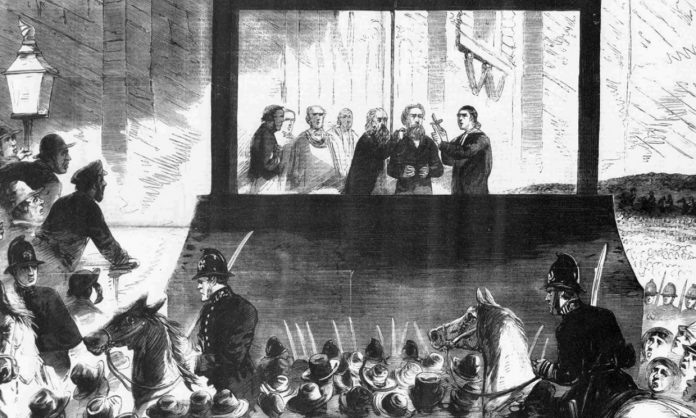by Betty Leigh
On the 26th May 1868 Michael Barrett, an Irish Fenian, became the last person to die by public execution in England.
Barrett’s story goes back to the Fenian Rising of the previous year, 1867, after which a number of Fenians were given prison sentences. Two prisoners in particular, Colonel Richard Burke and Joseph Theobald Casey were held in Clarkenwell House of Detention, better known as Clarkenwell prison.
On the 13 December 1867 a desperate attempt was made to rescue the two prisoners. At a quarter to four that afternoon a barrel of gunpowder was placed outside one of the prison walls. Inside that wall was a yard where Burke and Casey were supposed to exercise every day. The gunpowder was ignited, causing a huge explosion and making a breach in the prison wall. The resulting gap measured about twenty feet wide at the base and seventy feet at the top.
The houses directly opposite, in Corporation Lane were completely destroyed and many others in the neighbourhood were badly damaged. Twelve people were killed and forty injured. But the intended rescue of Burke and Casey did not take place due to the fact that the authorities had been warned of the plan in advance and had moved the prisoners to cells in another part of the prison. Judging by the strength of the explosion perhaps the prisoners were lucky not to have been in the yard.
One of those killed in the explosion was Sarah Ann Hodgkinson. Six people were charged with her murder. The six included two brothers, Timothy and William Desmond, John O’Keeffe, Michael Barrett and Nicholas English. A woman named Ann Justice was also arrested.
Ann was freed because of lack of evidence. Two days later O’Keeffe was also released for the same reason. And at the end of the five day trial the jury acquitted English and the Desmond brothers. Barrett was found guilty. His defence had been that he was in Glasgow at the time of the explosion. A number of witnesses gave sworn evidence in support of his alibi, but there were eyewitnesses and an informer who said that Barrett was the leader of the plot. Barrett was sentenced to death after making an eloquent speech from the dock.
Barrett was held in Newgate prison, which had been built around the year 1200, and had been rebuilt several times during its grim history. Public executions had taken place for centuries outside Newgate and vast crowds used to gather to see them. Unfortunately, most of the people in these crowds regarded the executions as a form of entertainment and a day out.
The crowds would arrive before dawn and wait for the condemned man to be led out through the small door in the prison wall. And such was the scene when Michael Barrett was led out to his execution at seven o’clock in the morning of the 26th May 1868. According to ‘The Time’ reporter “a great hungry shout” was raised by the crowd when Barrett appeared. He mounted the steps to the gallows and spoke quietly to the priest before being hanged.
It was the last public execution to take place in England and Newgate Prison was demolished in 1903, making way for the Central Criminal Court (The OldBailey).








